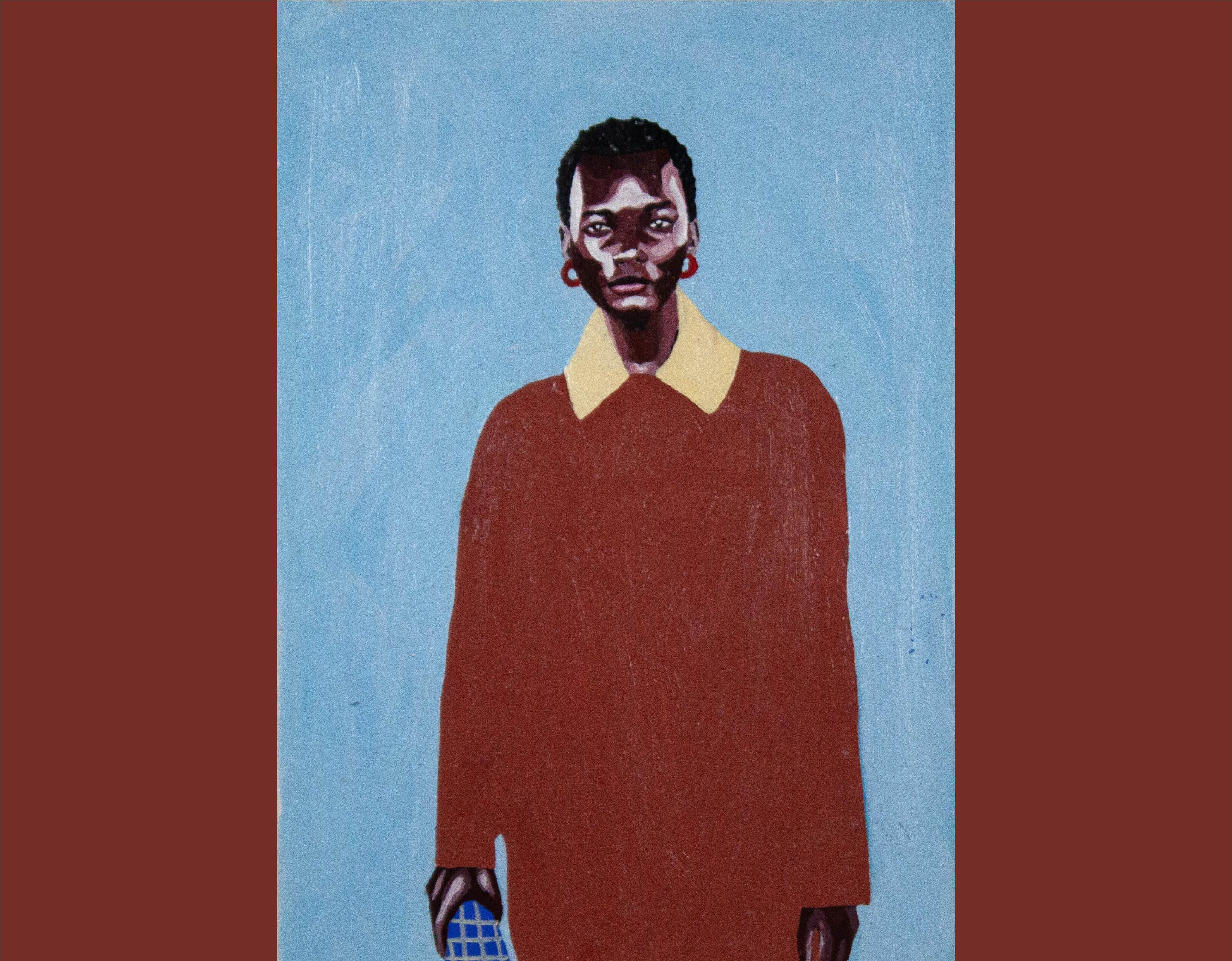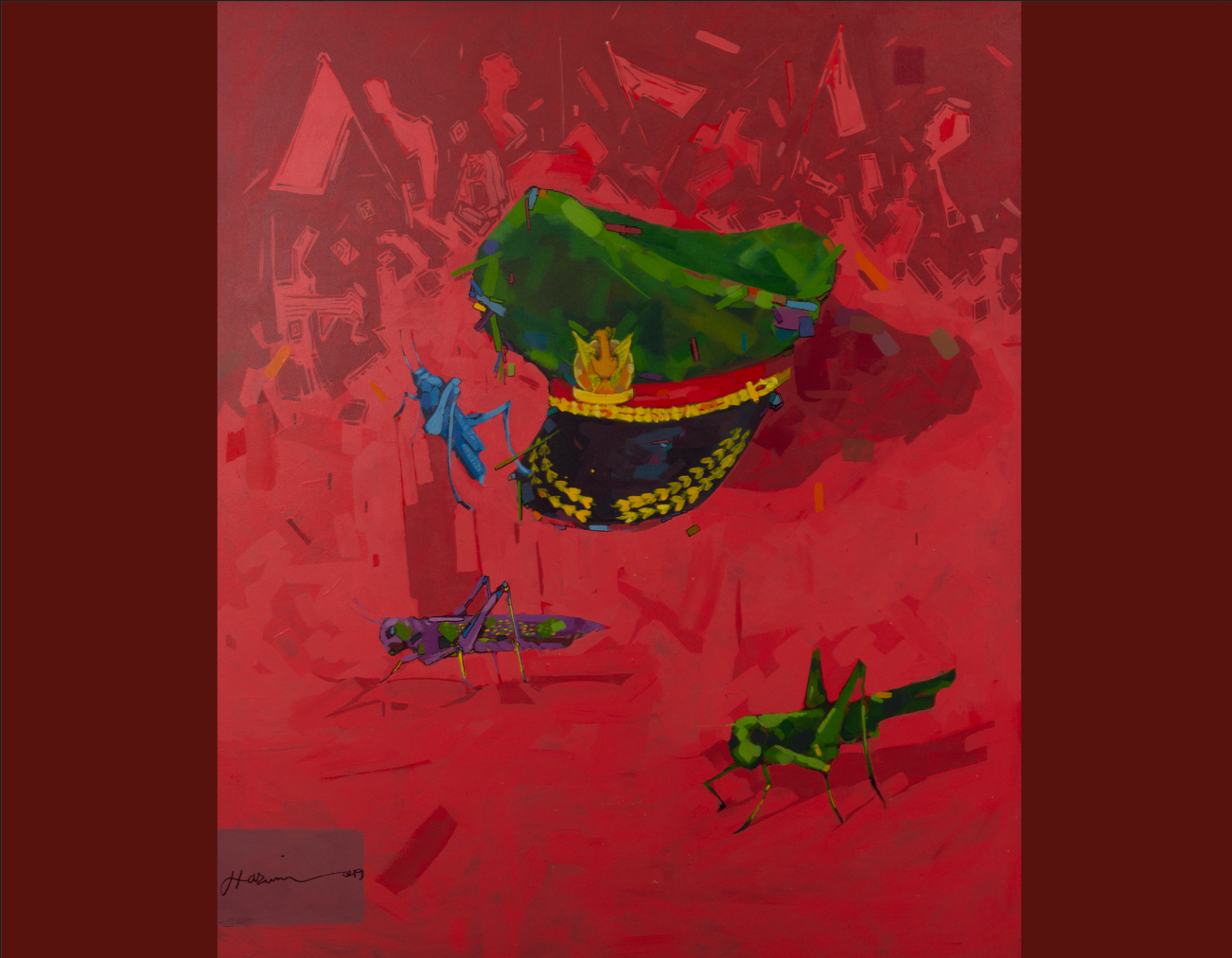An interview with Urte Remmert

An interview with Urte Remmert
Martha Mukaiwa
A spacious garage in the picturesque coastal town of Swakopmund doubles as an art studio and art school for veteran Namibian artist and arts educator, Urte Remmert.
Born in Germany in 1952, and a graduate of the University of Cape Town’s Michaelis School of Fine Art, Remmert’s artistic expression takes flight in acts of pasting, sewing, tearing, and embroidering.
Remmert’s canvases range from handmade paper and discarded maize-meal sacks to traditional textiles and vintage doilies. Through an intuitive process of reconstruction, Remmert transforms what is pasted, sewn, torn, and retooled into profound installations, as well as complex mixed-media and embroidered portraiture.
Largely concerned with human interrelation as well as the realities of poverty, hardship, and violence faced by Namibia’s women and children, Remmert also mines the personal caverns and trauma-ridden hollows of her personal history.
An award-winning and socially conscious artist, her awareness of issues of race informs a practice that seeks to reflect the diversity of post-independent Namibia. Her artistic methodology includes knowledge of current affairs as well as extensive research into notable artists and contemporary discourse.
Now over 70-years-old, Remmert continues to make and teach art, hoping that she will have ‘the strength and critical mind to continue on my path in the creation of unique, questioning and inspiring art’.
Martha Mukaiwa speaks with the artist for ARAK.
Why do you make art, and when did you first start making art?
There was always an urge to understand my world and come to grips with beautiful, striking or even unsettling happenings in Namibian communities.
What would you say is original about your work, and how do you reconcile influence and innovation?
As I am always searching to express my thoughts in an innovative way on certain topics, I choose my materials and way of working accordingly. Surely every artist has certain influences that shape their thoughts and the artistic outcome, be it a book, materials or colours that inspire, an artist or a photograph.
Tell us a bit about your training. Are you self-taught or shaped by institutional values?
I was lucky to have a mother who had studied art and furthered my explorations in creating. I started very young and, at 17, I studied art at the University of Cape Town’s Michaelis School of Fine Art.
What are some of the key themes, colours, materials and interests animating your work?
Human beings, especially women and children, and their struggle to find a way of living a meaningful, fulfilled life in dignity despite poverty, hardships and violence.
Patchwork People, one of my bigger works for which I won a prize at the last Triennale in Windhoek, was created in a complicated layered triptych made of scraps of old paper, as well as threads and patches that left their imprint on the land and its inhabitants.
The persons on the canvases seem to be caught up in their own difficult and hurtful past. They are still, as if frozen, not able to move. I hoped viewers would stop in their tracks to reflect on the work and Namibian society at large.
Recently, I have started a series of black pen/brush and ink drawings with bleach that depict landforms in a rather abstract style, using titles like:
The Flow
Infinity
From Above
A human being can find themselves in a landscape, in the curve of a river, in an outcrop or in shifting desert sand.
My soul is in sync with my surroundings. Meditating on the nature of topography results in a sense of peace and security, of remembering home as a place of belonging.

What do you think is the relationship between art and society?
All art is closely intertwined with movements in society. It is a powerful voice for justice, self-expression, equality and identity. Through art, artists can amplify voices that would otherwise not be heard.
Cross-cultural collaboration and exchange create unique perspectives and cultural influences and foster understanding. I have been an art teacher for primary and high schools for 50 years and I am adamant that art is one of the tools to inspire critical thinking, creativity and understanding of the world.
What does the term 'Contemporary African Art' mean to you?
To me, it means an explosion of diverse styles, materials, and expressions all over Africa, be it in painting, using recycled objects to create, employing traditional techniques to achieve artworks that are loaded with historical significance or delving into the digital possibilities of creating.
The artist in Africa is not limited by the art theories and perceptions of the colonial past!
Cyrus Kabiru makes sculptural glasses from scrap found on dump sites. He says about his photographic portraits with glasses: ‘They confuse seeing and being seen, object and performance.’
What role do you think art institutions play in shaping the discourse around Contemporary African Art?
- challenging the status quo
- challenging discrimination
- building bridges between people of many backgrounds and traditions
- giving African artists a voice
- bringing about a positive view of local artists, thus influencing the young generation of African creatives to use their talents for social change.
Do you see a relationship between art and activism within the context of Contemporary African Art?
Absolutely. Under the vibrant colours, patterns and exciting forms there are the haunting messages of discrimination (LGBTQ), racism and social injustices that are actively discussed and explored in panels all over Africa. There are numerous publications, workshops and critical social movements to raise awareness and bring about change.
Do you think that African art is a global game-changer?
Yes, I am convinced that African art, which combines design and crafts skills that have been passed on for generations, will play a dynamic role in the growing art scene in Africa and abroad. Kabiru, a Kenyan artist, says: ‘We need to move from selling poverty to selling creativity.’

How does geopolitics factor into the making of art?
Decolonising and reshaping ideas and views to spark new ways of artistic creation that engage with contemporary societies. This very often results in striking artworks. Very often the coming together of different artists employing diverse skills in the group like photography, film, theatre, crafts, dance, music and poetry to shape the final outcome and share ideas and criticism is put to use.
This collaboration has been a cornerstone of African art and recently this attracted international investments. Thus, artists such as El Anatsui and William Kentridge are gaining recognition on the global stage.
Do you have a sense of your audience? How important is the consideration of an audience when making art?
When I create, I am not really thinking of the audience. Instead, I am very much involved in an idea, a concept or way of using materials in the best possible way. However, as I frequently work on topics that are critical of society, the audience is somehow ‘hovering around me’.
How does Africa or the African diaspora factor into your work?
I find myself as a white, elderly, female artist in an African country that is my home and has experienced horrific human rights abuses and exploitation of its peoples. This fact alone is already an extremely difficult starting point for making relevant art.
My latest works are inspired by issues in Namibia like gender-based violence, poverty, intolerance and exploitation. Human relationships, women and children play a big role in my work. My ideas are sourced and developed from newspapers and magazine articles on current affairs. Also, my experimentation with diverse materials (collages) and extensive research into artists and topics create a new awareness of the world I live in.
What role do you think criticism/art writing plays in the contemporary art market? What does it mean for your own practice?
They have the following effect:
- thinking out of the box
- trying new ways of making art
- discussing results and outcomes in groups and with art lovers
- inspiration
- re-thinking of answers that have been taken for granted
This interview has been edited for brevity and clarity.
Cover artwork: Urte Remmert, My Story, Your Story, Our Story, acquired 2022. Embroidery and patchwork, 92 × 70 cm.
.svg)


.svg)
.svg)
.png)

